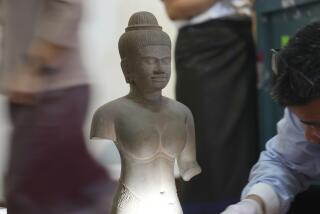Ancient Art for a Modern Crowd
- Share via
MEXICO CITY — The Mayas were always the favorite pre-Hispanic people among archeologists, anthropologists and historians. Now Maya culture is winning the same kind of admiration from the public, as hundreds of thousands of visitors view its breathtaking artworks.
Mexican curators have assembled the largest-ever exhibition of Maya art--557 pieces in all, including human-sized sculptures, funeral masks and columns laced with intricate glyphs--to show off the richest ancient culture of the Americas.
The works come from 40 museums in Mexico and from the four Central American countries on whose territory the Maya civilization also existed from 1800 BC until 1524, when Spanish conquistadors first reached the Mayas in what is now southern Mexico.
The show’s importance lies in its scope in gathering the best Maya works from so many different museums. For example, a life-size sculpture of a male ballplayer is being seen intact for the first time; the lower torso and legs come from a museum in Merida, the capital of Yucatan state, while the chest and head have been displayed in a museum elsewhere.
More than 600,000 people visited the exhibition during its run earlier this year at the Palazzo Grassi in Venice, Italy. And more than 326,000 have visited the exhibition here since it opened in early August in the 400-year-old Colegio de San Ildefonso museum in Mexico City’s historic center. The exhibition continues until Dec. 30.
The show forms part of a broader revival of things Maya. Important recent discoveries, such as a royal throne at the ancient city of Palenque in Chiapas state, have prompted a jump in tourism to ancient Maya ruins. At the same time, the Mexican government is aggressively promoting the “Mayan Route,” including the Caribbean coast south of Cancun and inland ruins such as Chichen Itza in Yucatan and lesser-known marvels such as Calakmul in Campeche state.
Among the cultures that predate the region’s conquest by Spain, the Aztecs have long attracted more attention, said exhibition curator Mercedes de la Garza Camino, “perhaps because they had the most spectacular first contact with foreigners.” Spanish conqueror Hernan Cortes overwhelmed the Aztecs in a fierce war ending in 1521 with his destruction of the Aztec capital, Tenochtitlan. He built the colonial capital of Mexico City atop the ruins.
The Mayas, in contrast, fended off total conquest by the Spaniards until 1697, and they remain Mexico’s most important indigenous minority even as others have been largely absorbed into the mestizo, or mixed, culture. Today, the 28 Maya languages are spoken by more than 4 million people, from Chiapas through the Yucatan Peninsula and into Guatemala, Belize and Honduras.
Art historian James Oles, who teaches pre-Hispanic art history at Wellesley College in Massachusetts, wrote in a review of the show here for the daily newspaper Reforma that the sheer quantity of pieces can make the show exhausting for nonspecialists.
Yet he added that the qualities of Maya art, from the delicate profiles of the ruler Pacal and his wife to the fine clay figurines found buried on the Gulf of Mexico island of Jaina, appeal broadly: “Naturalism and sensuality permeate the Mayan aesthetic, making it easy to appreciate from a Western perspective.”
De la Garza, a renowned historian and director of Mexico City’s famed Museum of Anthropology, noted that Maya achievements include the most complex writing system in the Americas. Moreover, the Mayas were brilliant mathematicians.
“They were the first people anywhere to use the zero and to devise the positional value of numbers,” she said. “And they did this 1,000 years before the Europeans.”
Experts throughout this century have been slowly deciphering the finely detailed glyphs and the meaning of the intricate symbolic art of the Mayas. The Maya heaven had 13 levels and the underworld nine. The famed book of Maya culture, “Popol Vuh,” describes the basic Maya belief that people were created to feed the gods--for example, with blood from human sacrifices.
Though the Mayas are often regarded as a peace-loving counterpart to the warrior Aztecs, the exhibition reveals many signs of human sacrifice and warfare, often ritual battles in honor of the gods.
“The exhibition is designed to show the great cultural achievements of the Maya through their art,” De la Garza said. “We have reunited examples of all the artistic styles so that people will leave the exhibition with an understanding of the culture.”
More to Read
Sign up for Essential California
The most important California stories and recommendations in your inbox every morning.
You may occasionally receive promotional content from the Los Angeles Times.













